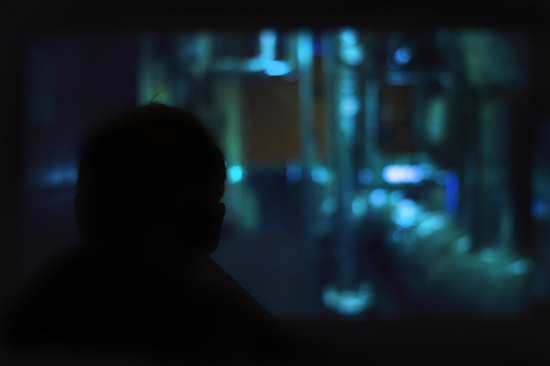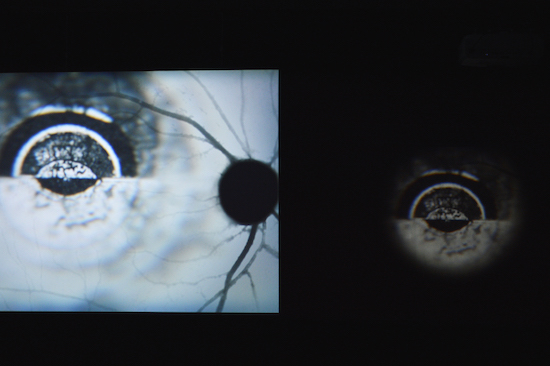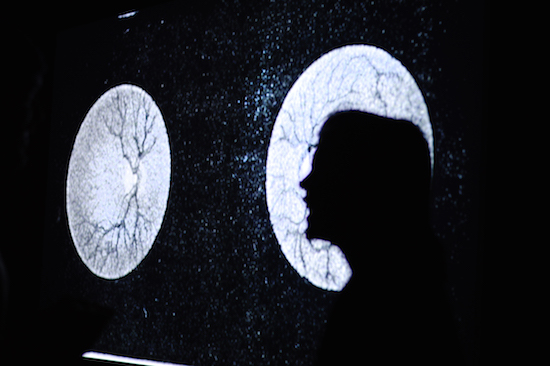Suki Chan’s Lucida is a journey. A journey, not just literally, on a projected screen, guiding the viewer through the corridors and stairwells of Senate House in London. But a journey, also, into the normally obscure interior of the body and its mechanisms, here exposed in all their fragility and contingency.
Named after William Hyde Wollaston’s (1807) device, a "light chamber" constructed of a tilted mirror and a projected surface, intended for use as a drawing aid for artists, Lucida consists of two projected moving images: the first, a pre-recorded guided tour through the famous Bloomsbury landmark; the second, a real-time image of the viewer’s own retinas, scanned a la Mission Impossible, as they watch the first film unfold. The work continues the artist’s investigation into ancient optical devices begun with her 2014 camera obscura at London’s Tintype gallery.
Born in Hong Kong in 1977, Chan’s work has long been concerned with the active nature of spectatorship. Her (2012) film, Still Point dealt with the capacity of inhabitants of different Jerusalem districts to "unsee" each other. 2014’s Obscura played with time and space and the physical processes of vision with hallucinatory effect. This new work, at the Centre for Contemporary Chinese Art in Manchester, continues and deepens these investigations.
The following interview was conducted in person at the CFCCA, a free entry innovative gallery based in the Northern Quarter of Manchester. The CFCCA begun in 1986 in the China Town of Manchester, but after many successful years at the gallery, in 1996 they moved into the up and coming Northern Quarter of Manchester only to be set back by being destroyed by a fire in 1999 – but it was quickly restored, and is still going today!
Meeting Suki Chan at the CFCCA, meant I actually got to see her in work a little as she was still taking photos of the exhibition at work whilst she was there. When speaking to Suki Chan it became clear that not only was she passionate about showing people what amazing things their eyes and brains can do, but also that we should use this gift whilst we still can as she pointed out very quickly that our eyes are incredibly fragile. Suki’s enthusiasm during the conversation for showing us more about the biology of our eyes and their practical use inspired me to look at my eyes in a totally different, less shallow way and be much more grateful for their already amazing design and functionalities.
Excuse the pun, but Suki Chan’s latest addition to her Lucida collection is an exhibition that is far more than meets the eye. Lucida begins with entering a dark room, taking a seat then watching one projector take you through Senate House, London and another showing the movement of your retinas in real time giving you a new found respect of how fragile but active your eyes really are.
Lucida in not just stunning in terms of the audio and visuals, but also sparks a natural interest in our own biology proving to be an educational experience. Lucida is made even more special by how modest, accessible and well explained the information that is key to is made to the viewer during the exhibition.

How did you first start out putting exhibitions like this together?
My very first commission after I left Goldsmiths, was with the Centre for Chinese Contemporary Art, which is how I started doing it outside of college and into the public realm, learning how to commission and produce an installation. It’s nice to be back in Manchester, everything is much closer together – you can get more done easier here than in London where I’m based.
What was it about the relationship between cameras and eyes that interested you originally?
In 2014 I was commissioned by Tintype gallery in London to produce film about Essex Road where the gallery is located. I thought it’d be a great idea to black out the gallery space and create a camera obscura inside because we would be able to see the street projected inside but upside down. It’s a really beautiful phenomenon because although we understand how optics work, it’s still really magical when you see an actual real street scene projected inside. It’s nuts – you see the traffic going past but the traffic is up on the ceiling!
Whilst I was doing this I realised this is what it must be like to be transported to the inside of our eyes and really, the eye is like a camera, like a darkened chamber – a camera obscura.
What lead you from Obscura to your current exhibition – Lucida?
After I finished working on the camera obscura I started looking at other optics and found the camera lucida, which I originally liked because of the name. ‘Lucida’ means ‘light’ in Latin whereas ‘obscura’ means dark and camera means chamber, actually. It made sense to do it this way as both are focused on light, reflections and refractions.
Although there is music and speech during the roving film that takes you through the library in Lucida, it is still predominately all about sight. What was it about this sense that fascinated you the most out of the five senses and inspired you to create this piece?
Sight is the most dominant sense and that’s the one that I think the majority of us use, also a large part of our brains is dedicated to processing visual data. Sound was very important in this too though. I did some field recordings and composer Dominik Scherrer used some of these alongside his own library of recordings to make the music for Lucida.

Alongside the differences made by light and dark in your films, both in sense of tone and the way the films look, how do you find the natural colours in the setting of Lucida effect the way the film is taken in?
I choose the spaces because I think they’re appropriate with the colour and light, and the way the light sculpts the space – or the lack of light, like the tunnels or the boiler room you see in the film.
With the tunnels and boiler rooms in the film, did this spark any interest in taking urban exploring any further?
In 2009, I made a film called Sleep walk, Sleep talk which I did quite a bit of urban exploring for where it started with some beautiful aerial shots of London – noticing patterns in the way people move around the city. Then I went into the tube and shot some film from the front carriage which gave a sense of lonely experiences from the way the tube moved.
The tunnels in Lucida, however, were not about this, but instead it was an analogy of our optic nerve.
Do you find yourself looking at your own eyes more objectively since this exhibition?
Yes! Definitely, a big part of Lucida I and II is that I interview people who are partially sighted, visually impaired or losing their sight with age. Not as a “look at these poor people” but actually that this is going to affect the majority of us, so it’s also to raise awareness that we don’t have sight forever so it’s to help us appreciate it and how fragile our eyes really are.
I didn’t actually interview anyone who was colour-blind but that’s because it is quite common. Synaesthesia is really fascinating though. Apparently most children have it but as our brains develop there is a process called synaptic pruning which is where connections that aren’t useful get pruned – however some people retain it as an adult. Most of us do start off with synaesthesia connections.
Lucida III is opening in Miami later this month, what can people expect from that?
There will be an image with frosted hexagonal shapes and that layer is our cornea, which is how it would look under microscope. This is also interactive because as you concentrate on the image, it begins to melt away and then the viewer can control this and you can see your eye trail from this – which allows you to draw with your eyes and then able to even wipe away the frosted layer of the image. I’ve found by using interactive technology with this it really adds to the art of the films and hopefully gives a better understanding of the way our eyes work.
Suki Chan’s Lucida is at the CFCCA, Manchester, until 30 April


